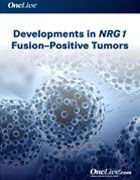Publication
Article
Special Issues
Case Series Highlights Afatinib Activity in NRG1+ Cancers
Author(s):
A case series presented at the 2019 ESMO Congress highlighted the activity of afatinib in patients with NRG1-positive tumors.
Stephen V. Liu, MD

Stephen Liu, MD
Afatinib (Gilotrif) is a potential treatment option for patients with NRG1-positive tumors across multiple cancer types. At the ESMO 2019 Congress, Stephen Liu, MD, and colleagues described a series of 7 pretreated patients with NRG1-positive tumors who were treated with afatinib with varying degrees of success.1
Of the 7 patients treated in the series, 4 patients had lung cancer, 2 had pancreatic cancer, and 1 had colon cancer. One patient with lung adenocarcinoma received 14 lines of therapy prior to afatinib, which included chemotherapy and erlotinib (Tarceva) plus gefitinib (Iressa). The longest duration of response was a partial response (PR) that lasted 24 months, said Liu, director of Developmental Therapeutics, Georgetown University.
“We know from previous work that this fusion event can occur in many different types of tumors, including cholangiocarcinoma and breast cancer. It’s a tumor-agnostic fusion event. Although it’s rare, it’s something you would pick up with next-generation sequencing, primarily through RNA sequencing.”
The NRG1 fusion leads to the constitutive activation of the HER3/HER4 pathway, which in turn, leads to activation of the PI3 kinase and the MAP kinase pathways, promoting cell proliferation, survival, and growth. “Agents [such as afatinib] that target HER3/HER4 would be agents that could have efficacy in the presence of an NRG1 fusion,” he said. “This series shows us that when you block the HER pathway with a drug like afatinib in the presence of an NRG1 fusion, you can induce responses and in some cases, durable responses.”
Multiple drugs, including monoclonal antibodies and bispecific antibodies, are in development that target NRG1 fusions, he added. Prospective trials with afatinib in patients with NRG1-positive tumors are ongoing and others are about to be launched. One prospective study is ongoing in the Drug Rediscovery Protocol trial. One soon to be launched is through the Targeted Agent and Profiling Utilization Registry (TAPUR), which is a multiarm basket protocol being run by ASCO.
The 7 patients treated in this series were as follows:
- A 70-year-old female, never-smoker with pan-wildtype, nonmucinous lung adenocarcinoma who received afatinib, 40 mg/day, for 24 months as her fifteenth line. She discontinued after 24 months due to progressive disease. An NRG1 fusion was then identified and she was rechallenged with afatinib, 30 mg/day, with a PR, for 3 months, before switching to atezolizumab (Tecentriq).
- A 66-year-old female, never-smoker with nonmucinous lung adenocarcinoma and multiple lung and lymph node metastases at diagnosis. A CD74-NRG1 fusion was identified and afatinib as fifth-line treatment was initiated. Several dose adjustments were made (down to 20 mg/day) due to diarrhea and malaise. After 19 months, afatinib treatment is ongoing, with PR.
- A 68-year-old male with a >20 pack-year smoking history with nonmucinous lung adenocarcinoma. A SDC4-NRG1 fusion was identified and afatinib, 30 mg/day, was started in the second line. Best response was stable disease (SD) with a duration of 4 months.
- A nonsmoking 43-year old female with advanced invasive mucinous lung adenocarcinoma. A CD74-NRG1 fusion was identified and afatinib was started in the third line. Best overall response on afatinib (40 mg/day) was a PR, and the duration of best response is 18+ months and ongoing.
- A 69-year-old male with KRAS-mutated colorectal cancer with multiple liver and lung metastases at diagnosis. The patient received 2 lines of treatment prior to afatinib, neither of which were tolerated. Following a right hemicolectomy and liver/lung metastasectomies, a novel POMK-NRG1 fusion was detected and afatinib (30 mg/day) was initiated. Best overall response on afatinib was SD, with treatment ongoing at 9+ months.
- Two males (54 and 59 years old) with KRAS wild-type, metastatic pancreatic cancers. Following progressive disease on chemotherapy, APP-NRG1 and ATP1B1-NRG1 fusions, respectively, were detected and afatinib at 30 mg/day and 40 mg/day, respectively, was initiated. The dosage was reduced to 30 mg/day in the 59-year-old due to diarrhea. Best overall response in both patients was a PR with a duration of best response of 8 months and 5.5 months, respectively.
Together with other published case reports, the findings solidify the identity of NRG1 fusions as an actionable alteration, said Liu. “When we use a targeted agent here, we can see dramatic, rapid, and durable responses,” he said. “What we don’t know is the response rate because these are case series, and people typically only report when there are good outcomes.
“The key is because the introns are so large, DNA-based sequencing will miss many of the NRG1 fusions, so the best test is an RNA-based approach to identify those more reliably, and when found, it’s important to identify trials for these patients.”
Liu SV, Duruisseaux M, Tolba K, et al. Targeting NRG1-fusions in multiple tumour types: Afatinib as a novel potential treatment option. Presented at ESMO 2019; September 27-October 1, 2019; Barcelona, Spain. Abstract 1969P.
<<< View more from the 2019 ESMO Congress
 
NRG1 is a growth factor that binds HER3/4 and activates ErbB signaling pathways. NRG1 fusions are transforming genomic events, Liu explained. NRG1 is fused to various partners, most commonly CD74. As a result of this fusion, the EGF-like domain of NRG1 is tethered to the plasma membrane. “The signaling is through the EGF-like domain, which acts as a ligand for HER3/HER4 heterodimers, so the actual signaling that leads to the oncogenic event is through the HER3/HER4 pathway,” he said.










